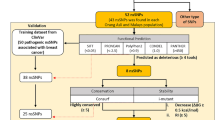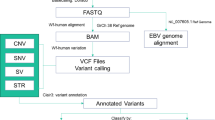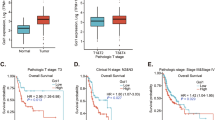Abstract
To identify a gene(s) susceptible to nasopharyngeal carcinoma (NPC), we carried out a genome-wide association study (GWAS) through genotyping of more than 500 000 tag single-nucleotide polymorphisms (SNPs), using an initial sample set of 111 unrelated NPC patients and 260 controls of a Malaysian Chinese population. We further evaluated the top 200 SNPs showing the smallest P-values, using a replication sample set that consisted of 168 cases and 252 controls. The combined analysis of the two sets of samples found an SNP in intron 3 of the ITGA9 (integrin-α 9) gene, rs2212020, to be strongly associated with NPC (P=8.27 × 10−7, odds ratio (OR)=2.24, 95% confidence intervals (CI)=1.59–3.15). The gene is located at 3p21 which is commonly deleted in NPC cells. We subsequently genotyped additional 19 tag SNPs within a 40-kb linkage disequilibrium (LD) block surrounding this landmark SNP. Among them, SNP rs189897 showed the strongest association with a P-value of 6.85 × 10−8 (OR=3.18, 95% CI=1.94–5.21), suggesting that a genetic variation(s) in ITGA9 may influence susceptibility to NPC in the Malaysian Chinese population.
Similar content being viewed by others
Log in or create a free account to read this content
Gain free access to this article, as well as selected content from this journal and more on nature.com
or
References
Brennan, B. M. Nasopharyngeal carcinoma. Orphanet J. Rare Dis. 1, 23 (2006).
Zhou, X. F., Cui, J., Macias, V., Kajdacsy-Balla, A. A., Ye, H., Wang, J. G. et al. The progress on genetic analysis of nasopharyngeal carcinoma. Comp Func Genomics Article ID 57513, 13 pages (2007).
Lim, G. C. C. & Halimah, Y. (eds) Second Report of the National Cancer Registry. Cancer Incidence in Malaysia 2003 (National Cancer Registry, Kuala Lumpur, 2004).
Abu Bakar, S. in Cancer Incidence in Peninsular Malaysia 2003–2005 (eds. Lim, G.C.C., Rampal, S. & Halimah, Y.) 71–73 (National Cancer Registry, Kuala Lumpur, 2008).
Devi, B. C., Pisani, P., Tang, T. S. & Parkin, D. M. High incidence of nasopharyngeal carcinoma in native people of Sarawak, Borneo Island. Cancer Epidemiol. Biomarkers Prev. 13, 482–486 (2004).
Raab-Traub, N. in Epstein-Barr Virus (ed. Robertson, E.S.) 73 (Caister Academic Press, England, 2005).
Armstrong, R. W., Imrey, P. B., Lye, M. S., Armstrong, M. J., Yu, M. C. & Sani, S. Nasopharyngeal carcinoma in Malaysian Chinese: salted fish and other dietary exposures. Int. J. Cancer 77, 228–235 (1998).
Jeannel, D., Bouvier, G. & Huber, A. Nasopharyngeal carcinoma: an epidemiological approach to carcinogenesis. Cancer Surv. 33, 125–155 (1999).
McDermott, A. L., Dutt, S. N. & Watkinson, J. C. The aetiology of nasopharyngeal carcinoma. Clin. Otolaryngol. 26, 82–92 (2001).
Hildesheim, A. & Levine, P. H. Etiology of nasopharyngeal carcinoma: a review. Epidemiol. Rev. 15, 466–485 (1993).
Goldsmith, D. B., West, T. M. & Morton, R. HLA associations with nasopharyngeal carcinoma in Southern Chinese: a meta-analysis. Clin. Otolaryngol. 27, 61–67 (2002).
Lieboitz, D. Nasopharyngeal carcinoma. The Epstein–Barr virus association. Semin. Oncol. 21, 382–397 (1994).
Hui, AB. T., Lo, K. W., Leung, S. F., Teo, P., Fung, M. K. F., To, K. F. et al. Detection of recurrent chromosomal gains and losses in primary nasopharyngeal carcinoma by comparative genomic hybridization. Int. J. Cancer 82, 498–503 (1999).
Lo, K. W., Teo, P. M., Hui, A. B., To, K. F., Tsang, Y. S., Chan, S. Y. et al. High-resolution allelotype of microdissected primary nasopharyngeal carcinoma. Cancer Res. 60, 3348–3353 (2000).
Xiong, W., Zeng, Z. Y., Xia, J. H., Xia, K., Shen, S. R., Li, X. L. et al. A susceptibility locus at chromosome 3p21 linked to familial nasopharyngeal carcinoma. Cancer Res. 64, 1972–1974 (2004).
Feng, B. J., Huang, W., Shugart, Y. Y., Lee, M. K., Zhang, F., Xia, J. C. et al. Genome-wide scan for familial nasopharyngeal carcinoma reveals evidence of linkage to chromosome 4. Nat. Genet. 31, 395–399 (2002).
Hildesheim, A., Anderson, L. M., Chen, C. J., Cheng, Y. J., Brinton, L. A., Daly, A. K. et al. CYP2E1 genetic polymorphisms and risk of nasopharyngeal carcinoma in Taiwan. J. Natl Cancer Inst. 89, 1207–1212 (1997).
Tiwawech, D., Srivatanakul, P., Karalak, A. & Ishida, T. Cytochrome P450 2A6 polymorphism in nasopharyngeal carcinoma. Cancer Lett. 241, 135–141 (2006).
Deng, Z. L., Wei, Y. P., Luo, W., Liao, Z. L. & Ma, Y. Glutathione S-transferase M1 and T1 gene deletion associated with increased susceptibility to nasopharyngeal carcinoma. The Chinese-German Journal of Clinical Oncology 4, 276–278 (2005).
Cho, E. Y., Hildesheim, A., Chen, C. J., Hsu, M. M., Chen, I. H., Mittl, B. F. et al. Nasopharyngeal carcinoma and genetic polymorphisms of DNA repair enzymes XRCC1 and hOGG1. Cancer Epidemiol. Biomarkers Prev. 12, 1100–1104 (2003).
Cao, Y., Miao, X. P., Huang, M. Y., Deng, L., Hu, L. F., Ernberg, I. et al. Polymorphisms of XRCC1 genes and risk of nasopharyngeal carcinoma in the Cantonese population. BMC Cancer 6, 167 (2006).
He, Y., Zhou, G., Zhai, Y., Dong, X., Lv, L., He, F. et al. Association of PLUNC gene polymorphisms with susceptibility to nasopharyngeal carcinoma in a Chinese population. J. Med. Genet. 42, 172–176 (2005).
Nasr, H. B., Mestiri, S., Chahed, K., Bouaouina, N., Gabbouj, S., Jalbout, M. et al. Matrix metalloproteinase-1 (-1607) 1G/2G and -9 (-1562) C/T promoter polymorphisms: susceptibility and prognostic implications in nasopharyngeal carcinomas. Clinica. Chimica. Acta. 384, 57–63 (2007).
Catarino, R. J., Breda, E., Coelho, V., Pinto, D., Sousa, H., Lopes, C. et al. Association of the A870G cyclin D1 gene polymorphism with genetic susceptibility to nasopharyngeal carcinoma. Head Neck 28, 603–608 (2006).
Song, C., Chen, L. Z., Zhang, R. H., Yu, X. J. & Zeng, Y. X. Functional variant in the 3 -untranslated region of toll-like receptor 4 is associated with nasopharyngeal carcinoma risk. Cancer Biol. Ther. 5, 1285–1291 (2006).
Zhou, X. X., Jia, W. H., Shen, G. P., Qin, H. D., Yu, X. J., Chen, L. Z. et al. Sequence variants in toll-like receptor 10 are associated with nasopharyngeal carcinoma risk. Cancer Epidemiol. Biomarkers Prev. 15, 862–866 (2006).
International HapMap Consortium. A haplotype map of the human genome. Nature 437, 1229–1320 (2005).
International HapMap Consortium. A second generation human haplotype map of over 3.1 million SNPs. Nature 449, 851–862 (2007).
Ohnishi, Y., Tanaka, T., Ozaki, K., Yamada, R., Suzuki, H. & Nakamura, Y. A high-throughput SNP typing system for genome-wide association studies. J. Hum. Genet. 46, 471–477 (2001).
Chan, A. S. C., To, K. F., Lo, K. W., Mak, K. F., Pak, W., Chiu, B. et al. High frequency of chromosome 3p deletion in histologically normal nasopharyngeal epithelia from southern Chinese. Cancer Res. 60, 5365–5370 (2000).
Takada, Y., Ye, X. J. & Scott, S. The integrins. Genome Biol. 8, 215 (2007).
Sheppard, D. Functions of pulmonary epithelial integrins: from development to disease. Physiol. Rev. 83, 673–686 (2003).
Guo, W. & Giancotti, F. G. Integrin signalling during tumour progression. Nat. Rev. Mol. Cell Biol. 5, 816–826 (2004).
Stewart, P. L. & Nemerow, G. R. Cell integrins: commonly used receptors for diverse viral pathogens. Trends Microbiol. 15, 500–507 (2007).
Young, L., Dawson, C., Brown, K. & Rickinson, A. Identification of human epithelial cell surface protein sharing an epitope with the C3d/Epstein-Barr virus receptor molecule of B lymphocytes. Int. J. Cancer 43, 786–794 (1989).
Birkenbach, M., Tong, X., Bradbury, L. E., Tedder, T. F. & Kieff, E. Characterization of an Epstein-Barr virus receptor on human epithelial cells. J. Exp. Med. 176, 1405–1414 (1992).
Lin, C. T., Lin, C. R., Tan, G. K., Chen, W., Dee, A. N. & Chan, W. Y. The mechanism of Epstein-Barr virus infection in nasopharyngeal carcinoma cells. Am. J. Pathol. 150, 1745–1756 (1997).
Acknowledgements
We thank all the participants in this study, Dr Shashinder Singh, Dr Anura Michelle Manuel and staffs of the Department of Otorhinolaryngology, Dr Veera Sekaran Nadarajah from the Department of Pathology, staffs of the Blood Bank, UMMC and Ms Maliza Nawawi from the NCI Cancer Hospital. In Malaysia, this study was supported by the Research University Grant (FQ018/2007A) from the University of Malaya.
Author information
Authors and Affiliations
Corresponding authors
Rights and permissions
About this article
Cite this article
Ng, C., Yew, P., Puah, S. et al. A genome-wide association study identifies ITGA9 conferring risk of nasopharyngeal carcinoma. J Hum Genet 54, 392–397 (2009). https://doi.org/10.1038/jhg.2009.49
Received:
Revised:
Accepted:
Published:
Issue date:
DOI: https://doi.org/10.1038/jhg.2009.49
Keywords
This article is cited by
-
A novel causal model for nasopharyngeal carcinoma
Cancer Causes & Control (2022)
-
Nasopharyngeal carcinoma MHC region deep sequencing identifies HLA and novel non-HLA TRIM31 and TRIM39 loci
Communications Biology (2020)
-
Clinical relationships between the rs2212020 and rs189897 polymorphisms of the ITGA9 gene and epithelial ovarian cancer
Journal of Genetics (2019)
-
Nasopharyngeal carcinoma: Advances in genomics and molecular genetics
Science China Life Sciences (2011)



